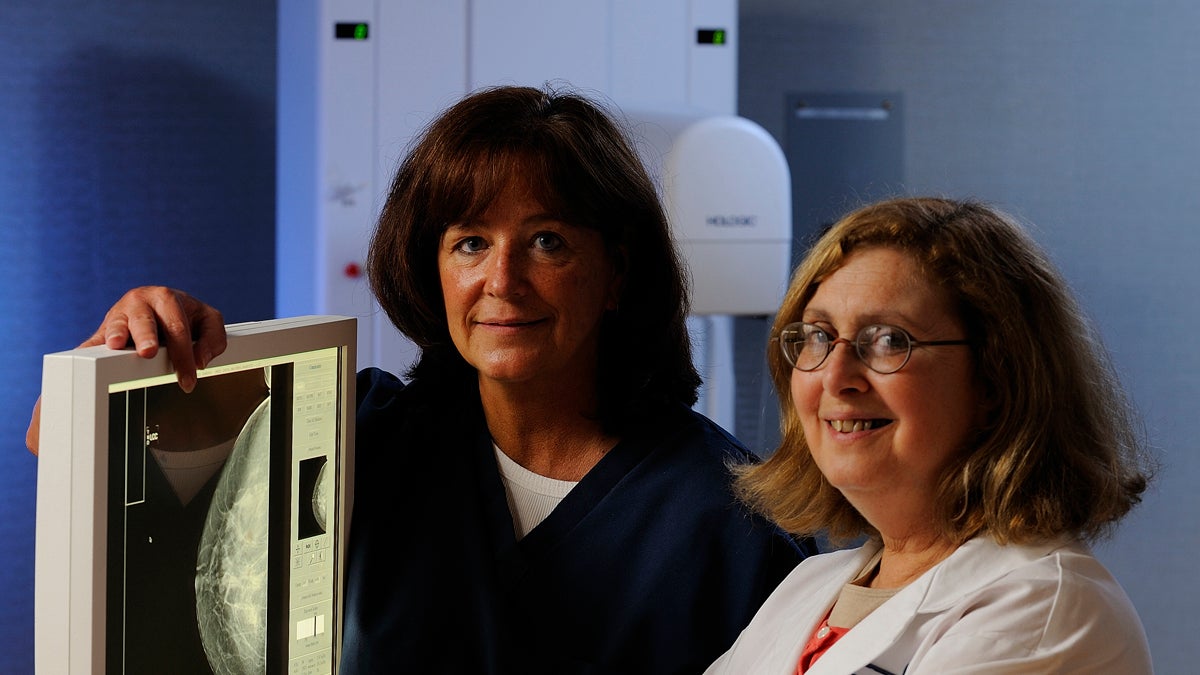New look at mammography affirms its benefits

From left, Jean Hummer, mammography superviser at Fox Chase Cancer Center, and Dr. Kathryn Evers, director of the center. (Photo courtesy of Fox Chase Cancer Center)
What’s a woman of a certain age supposed to do? Even the experts don’t agree about the value of mammography for breast cancer screening.
Robert Smith, senior director of cancer screening at the American Cancer Society, says those “apparent disparities” have lead to varying recommendations about the age women should begin mammography screening — and how often.
One way health professionals evaluate mammography is to count the number of women who need to get the screening test in order to prevent one cancer death.
“One scientist will say, ‘Mammography is just not that effective. You have to screen 2,000 women over 10 years to save one life. Another group would say, ‘Actually mammography is very effective. You need to screen 90 women over 30 years to save one life,” Smith said. “There’s been a huge range in the estimates of the benefits of screening.”
To reconcile the estimates of death rates and “over-diagnosis,” Smith and his study co-authors applied the same yardstick to four large studies.
Smith presented the “review of the reviews” this week at the 2013 San Antonio Breast Cancer Symposium
“The adjusted estimates ranged from 64 to 257 instead of the original 111 to 2,000,” Smith said.
Radiologist Kathryn Evers, who leads breast imaging at Fox Chase Cancer Center, is not affiliated with the new research but examined the new study.
“It’s a reslicing and dicing of the data,” Evers said. “So that you are really comparing apples to apples instead of apples to oranges.”
“My take away from all of this is that mammography is a useful tool,” Evers said. “Overall it’s a very good test.”
For their methodology, Smith and his team stripped out the data for women who were invited to get a mammogram but never showed up for the test. Their analysis also “takes a longer view,” Smith said.
“It’s time to figure out how well does it work among women who actually get it, and it’s also important to follow women long enough,” Smith said.
He’s not expecting everyone to be convinced.
“Mammography has been controversial from the start,” Smith said. “In many respects, this debate is quite similar to global warming, people pick their sides and they are not easily budged from them,” Smith said.
One note: Kathryn Evers at Fox Chase said the new study from Smith and colleagues does not resolve the debate over whether most women should begin routine screening at age 40 or a decade later at age 50.
Evers said detecting tumors early, when they are small, makes a difference to survival, and she said she gets her own screening test every year.
The members of the U.S. Preventive Services Task Force, which says most women could wait until age 50, include “lots of epidemiologists,” who typically have a population view of medicine, Evers said.
“While we all these days try to practice evidence-based medicine, still as clinician people, we look at the patient,” Evers said. “We look at the number of deaths attributable to this or that in a different way than someone who mostly works with numbers looks at it.”
WHYY is your source for fact-based, in-depth journalism and information. As a nonprofit organization, we rely on financial support from readers like you. Please give today.

